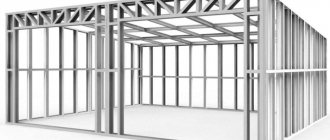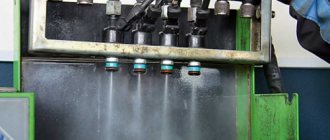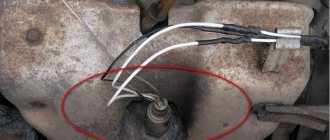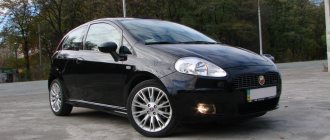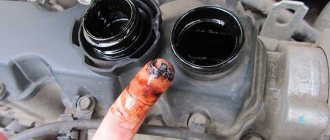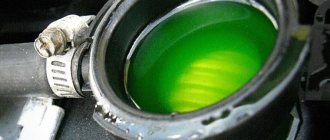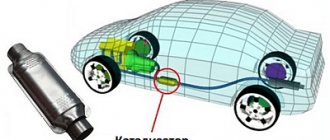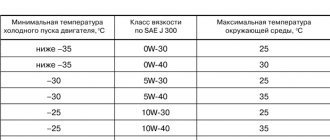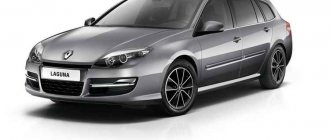VAZ 2104 is a classic 5-door, 5-seater station wagon, produced by the Volzhsky Automobile Plant. It is worth noting that in addition to VAZ, the “four” was produced at IzhAvto (2002-2012), as well as in Syzran, Kremenchug, Lutsk and even in Egypt. In total, the model was produced from 1984 to 2012. Its appearance was caused by the obsolescence of the “two” design (by the way, it was produced in parallel from 2104 to 1985). Since there was no station wagon based on the luxury “troika”, it was decided to produce it on the basis of an already produced one (yes, model 2105 appeared earlier than 2104 - this is normal practice at VAZ).
The appearance of the updated classic is completely different from its predecessors. The very first, striking difference is the straight chopped shapes, instead of the usual rounded ones. The second is the absence of chrome parts, they were replaced by plastic ones. The “face” is completely from the 2105 sedan - front block headlights with combined turn signals, side repeaters are also rectangular. The taillights were 90-degree rotated taillights from the 2105. It retained the wagon's 2102 955kg payload capacity. At the same time, it also retained the main drawback of this cargo platform - the rear suspension “cups” protruding inward. The fuel tank is the same as in 2102, on the left side. The roofs of classic station wagons had 2 parallel stampings that served as reinforcements.
Interior
The interior has also been completely changed compared to the previous station wagon. The interior was installed from 2105 - new door cards, seats, dashboard. The luggage space was now separated not only by the back of the rear seat - now there was a shelf installed there, similar to hatchbacks.
| Type | Volume | Power | Torque | Overclocking | Maximum speed | Number of cylinders |
| Petrol | 1.5 l | 53 hp | 96 H*m | 23 sec. | 125 km/h | 4 |
| Petrol | 1.2 l | 58 hp | 84 H*m | 18 sec. | 140 km/h | 4 |
| Petrol | 1.3 l | 64 hp | 92 H*m | 18 sec. | 137 km/h | 4 |
| Petrol | 1.5 l | 71 hp | 104 H*m | 17 sec. | 143 km/h | 4 |
| Petrol | 1.6 l | 74 hp | 116 H*m | 17 sec. | 145 km/h | 4 |
Many power units were installed on the car. At the beginning of production, engines familiar to many were installed: “three”, 1.5 liter, 77 hp. and, new at that time, a VAZ 2105 rotary engine with a volume of 1.3 liters. Later versions were equipped with VAZ 21067 and 21073 injection engines, 1.6 and 1.7 liters, and even a VAZ diesel engine. It was combined with a classic 4-speed "", and later versions with a 5-speed. It’s interesting that the car was equipped with a “sedan” main pair 3.9, or a 4.1 different from 2102.
Suspension
The suspension was inherited from its predecessor - a reinforced classic one. Namely, the front is independent, on levers with springs, and the rear is dependent, also with springs.
Since they were discontinued late, many cars remain in excellent condition today. Although, it is worth recognizing that the quality of the latest cars is much worse than the cars of that era. VAZ 2104 was exported under the name Lada Riva. There were also right-hand drive versions. Export cars were equipped with a speedometer graduated in miles. The Quartet has become perhaps the most popular domestic station wagon. It is actively used by Russian Post, having the appropriate coloring and a white-moon beacon on the roof.
photo of VAZ-2104 “Universal”
VAZ 2104
- a Soviet passenger car with a station wagon body type, developed at the VAZ plant. Serially produced from 1984 to 2012. The model was developed as a replacement for the outdated 2102 station wagon. For some time, 2102 and 2104 were produced at the plant in parallel. When creating a new model, the plant followed the path of least cost and used the VAZ 2105 as the base model. All spare parts were subject to maximum unification. To add rigidity, stampings appeared on the roof of the new model. Unlike the 2102 model, the “four” was equipped with a heated rear window as standard. From the mid-1990s, a rear windshield wiper was included as standard. The base model received the interior from the 2105. The station wagon's load capacity was 455 kg, almost double the maximum load capacity of the 2102. The model inherited the rear door design from its predecessor. Its edge coincided with the floor level, which made loading and unloading luggage easier. The rear seat folds down to create a huge loading area.
photo trunk of VAZ-2104
Disadvantages and advantages of the car
Like any other model, the Lada Granta has its advantages and disadvantages. The main disadvantages of the model include:
- There is noticeable play in the steering wheel. This deviation is clearly visible in the zero position, especially when driving along the highway, especially when it is uneven.
- The opening between the glass and the roof. It does not have a seal, which entails the possibility of corrosion.
- Somewhat ridiculous and inharmonious design.
- Poor quality door handles.
- Lack of roof rails to secure the trunk.
- Poor lighting in the rear of the car.
- Lack of temperature indication indicating the condition of the fluid in the engine.
- Limitation of maintainability due to weak fastening of hinges.
- Lack of headrests and foot mats as standard.
This does not make the Lada Granta worse and, due to its cost, is still in the lead. However, some little things really upset potential buyers. But if you put them aside and pay attention to the positives, it becomes much easier. The technical side of the car and its weight in running order are quite satisfactory. The performance characteristics and durability of the car are its main advantages. The machine is easy to maintain and high quality. Finally, it is not so difficult, and this process is not expensive financially.
Main advantages of the car:
- Gasoline consumption is optimal;
- weighs little;
- equipped with a modern dashboard;
- has good visibility and large mirrors;
- body base is long;
- minimal overhang;
- ground clearance is optimal;
- The trunk is roomy.
The car is truly considered the best of its kind. Lada Granta is still popular today.
This is the only domestic car distinguished by a compact body design and a spacious trunk. Most Grant owners are satisfied with their purchase, and minor design flaws can be easily eliminated with the help of tuning.
Any car, even the newest one purchased at a dealership, can end up in scrap metal; the reason for this can be a major accident, arson, vandalism, etc. In this case, if nothing is removed from the worker’s car, it’s just a pile of scrap metal. The cost of such a car for scrap metal will be equal to the cost of an old Zhiguli car, which is also sent to the press.
A new car is a rarity at a scrap metal site; as a rule, some of these cars are tried to be restored, and some are sold for spare parts. Mostly old Moskvich, Volga, Kopeyka, Zaporozhets and other heritage of the Soviet Union are scrapped. Mostly young people try to sell cars for scrap, they sell cars left over from their grandfathers, such cars simply take up precious space in the garage and the car seems to be “on the move” and can be used, but the price of such a car on the market is no more than 10 thousand rubles, and even sell problematic and time-consuming, so it’s easier to sell the car for scrap rather than “bother” with it.
Another option for a scrap car is abandoned cars in courtyards and city streets, each of us has seen such cars, especially a lot of them appear after winter, which is why such cars are nicknamed “snowdrops”. The reason for the ownerlessness of the car may be the death of the owner, he was sent to prison, he moved, or he simply no longer needs it. If such a car has been standing for several years, then the owner will probably not be found. In this case, the HOA (if the car is in the yard) as well as the city’s utilities have the authority to get rid of such a car, having previously resolved all issues with the city traffic police.
Modifications of VAZ-2104
The following models were produced: - 21041, 21043 and 21043-07, distinguished by 1.2 liter, 1.5 liter engines and a “seven” interior, respectively. In 1994, the VAZ-2104 with a 1.3 liter engine was discontinued. Today, the base model is the VAZ 21043 with a 1.5 liter engine and a five-speed manual transmission, which makes the VAZ 21043 AW car more dynamic and enjoyable to drive. Not long ago, a modification of the VAZ-21045 appeared with an atmospheric (non-aspirated) diesel engine produced by Barnaultransmash, with a volume of 1.52 liters.
| VAZ-2104 | VAZ-2105 engine, 1.3 liters, carburetor, with 4-gearbox), base model |
| VAZ-21041 | VAZ-2101 engine, 1.2 liters, carburetor with 4-speed gearbox. Not serially produced. |
| VAZ-21042 | VAZ-2103 engine, 1.5 liters, right-hand drive |
| VAZ-21043 | VAZ-2103 engine, 1.5 liters, carburetor with 4- or 5-gearbox, in versions with electrical equipment and interior from the VAZ-2107 |
| VAZ-21044 | VAZ-2107 engine, 1.7 liters, single injection, 5-speed gearbox, export model |
| VAZ-21045 | VAZ-2107 engine, 1.8 liters, single injection, 5-speed gearbox, export model. Not serially produced. |
| VAZ-21045D | engine VAZ-341, 1.5 liters, diesel, 5-gearbox |
| VAZ-21047 | VAZ-2103 engine, 1.5 liters, carburetor, 5-speed gearbox, improved version with interior from VAZ-2107. Export modifications were equipped with a radiator grille from the VAZ-2107. |
| VAZ-21048 | engine VAZ-343, 1.8 liters, diesel, 5-gearbox |
| VAZ-21041i | VAZ-21067 engine 1.6 liter injector, 5-gearbox, interior and electrical equipment of VAZ-2107 |
| Export names VAZ-2104 | |
| Lada Riva | UK and mainland Europe |
| Lada Nova | Germany and mainland Europe |
| Lada 1500 or Lada Signet | Canada |
| Lada Laika | Brazil |
photo of VAZ-2104 rear view
photo of VAZ-2104
Brief description and history
It is the VAZ 2101 that is the oldest model of the Volzhsky Automobile Plant, with which the history of the domestic automobile industry began. On April 19, 1970, the first small car rolled off the assembly line of the plant. The model was based on the Fiat 124 of the 1966 model year. In fact, the first “kopecks” were practically Italian cars, because The technical characteristics of the VAZ 2101 and Fait 124 were not much different from each other: a 1.2-liter engine and an entry-level interior trim. There was practically no difference between the cars.
Subsequently, domestic car designers significantly improved the design of the car to suit the operating conditions in our country. The ground clearance has been increased because... The quality of the road surface did not always allow travel with convenience and comfort. The body and suspension were significantly strengthened, thereby improving the technical characteristics of the VAZ 2101. The rear disc brakes from Fiat were replaced with drum brakes. This was explained by their durability and resistance to dust and dirt, which was always enough.
Almost everything has undergone changes, including the engine design. The distance between the cylinders was increased (this made it possible to bore the diameter of the cylinders), the camshaft was moved to the cylinder head. In addition to the engine, changes were made to the clutch, gearbox, and rear suspension. As a result, the weight of the car increased by 90 kg. In total, there were more than 800 changes and differences in the design of the VAZ 2101.
From 1970 to 1986, about three million VAZ 2101 cars were assembled at the plant. 19 years after the car left the assembly line, the first commercial copy took pride of place in the AvtoVAZ museum.
Interior and control design
In general, the design of the VAZ-2104 model
, like all classic models, ascetic. But the interior of the car can be different depending on your desire. A more economical option involves a standard panel with a minimum required set of switches and instrumentation, upholstery and seats with standard artificial leather headrests, and rubber floor mats. If you want more comfort, then you are offered an improved interior, an original steering wheel and instrument panel with an additional center console, which has an expanded set of function keys and control equipment. The improved interior includes seats upholstered in brushed jersey (the front ones have a high backrest), doors with integrally molded pads, and brushed floor mats. This version of the “four” will allow you to feel comfortable even on a long trip.
photo interior of VAZ-2104
Where to sell your car for scrap metal
If you still decide that it’s time to scrap your old car, then you should contact the large ferrous metal acceptance centers in your city. The larger the metal warehouse, the higher their price - this is as a rule. But it also happens that a recently opened reception area may offer prices a little higher in order to get more customers and promote its name.
First of all, look for “Vtorchermet” in your city - this is a large network of bases throughout Russia, interconnected only by name, this used to be the single and only enterprise of the USSR for the procurement of scrap, but now the name “Vtorchermet” has become a brand.
Do a little monitoring of prices - they will not differ much, the maximum difference can be 300-500 rubles per ton. Therefore, it is easier and faster to contact the base that is closest to you. Also, before making change, ask if there is cash at the till, because... It often happens that acceptances are calculated only the next day - there is no money in the cash register.
VAZ-2104 engine and its features
Engine 2104-1000260
can be used for installation on VAZ 2103, 2104, 2106, 21053, 2107 cars. Initially, the VAZ 2104 engine was produced only in a carburetor version. Subsequently, it was modified to use a fuel injection system and received the designation VAZ 2104-21. The VAZ 2104 engine was created on the basis of the previous model - VAZ 2103. The design used: a cylinder block, a connecting rod and piston group, a timing drive and a crankshaft from the 2103 engine.
photo VAZ-2104 engine
Cylinder block from a VAZ 2103 engine. Cylinder diameter - 76.00 mm. The accepted overhaul dimensions are 76.40 and 76.80. The engine is equipped with a crankshaft 2103 or an interchangeable shaft model 21213. To ensure the operation of the injection system, it was necessary to install components and parts from other engines that were originally developed for an injection fuel supply system. A new camshaft drive cover is used, on which there is space for installing a sensor that controls the position of the crankshaft. It was necessary to install cylinder head 2104-1003015, an original design, with enlarged areas for the intake manifold. The design of the head provides for the installation of nozzles. The camshaft, valves and springs correspond to those installed on the VAZ 2103 engine. The installation of hydraulic supports for the valve levers is not provided. The timing drive is carried out from a double-row bush-roller chain 2103-1006040. The chain tensioning mechanism is mechanical, similar to the device on the VAZ 2103 engine.
A pulley with a damper and a drive disk 21214-1005058-11 is installed on the crankshaft. To drive the generator, a belt 2107-1308020 is used (length - 944 mm). The injection modification 2104 has an original power system. The system includes an electric fuel pump with a fuel level indicator sensor, fuel lines, a fuel filter, a fuel rail with injectors, an air filter, air supply hoses, a throttle valve and a fuel vapor recovery system. To clean the air entering the engine, an air filter model 2112 is installed. A receiver model 2104 or model 2123-1008027 is installed together with the intake manifold. To adjust the volume of incoming air, a throttle pipe 2112 is installed. The electric fuel pump module 21073-1139009 is installed in the tank and supplies fuel to the fuel rail and injectors. The original fuel rail 2104-1144010 is used, box type with pressure regulator and return drain pipe. Injection is carried out using four nozzles of pair-parallel action. It is possible to install nozzles BOSCH 0 280 158 502 (black, thin), SIEMENS VAZ 6393 (beige, thick) or other types with the appropriate parameters. The ignition system includes: a Model 2112 ignition module mounted on a special bracket on the cylinder block, spark plugs and high voltage wires. The ignition module includes two ignition coils and two electronic control devices. In accordance with control signals from the control unit, the ignition module generates and supplies high-voltage pulses to the spark plugs. Ignition control is assigned to the electronic engine management system. This system controls the amount of air and fuel supplied to the cylinders, controls the operation of the fuel pump, controls the supply of high-voltage pulses from the ignition coil to the spark plugs and adjusts the ignition timing, regulates the crankshaft speed at idle. The main control element of the system is the electronic control unit (ECU)-controller. The engine complies with EURO-2 toxicity standards.
In April 1985, the “four” completely ousted the first VAZ station wagon, 2102, from the assembly line.
At the same time, it received several original rear parts from its predecessor.
The “four” is based on the VAZ-2105 with a sedan body. In those days, one of the main tasks of the designer when creating a new model was the need to combine maximum consumer effect with minimal production costs. Comfort is a relative concept here. For example, a windshield wiper and electric rear window heating appeared on stock VAZ-2104 only in 1994. In addition, in order to attract new buyers, later modifications of the four were equipped with a 5-speed gearbox. Changes also affected the interior of the car - in particular, the VAZ-2104 began to install anatomical front seats from the “Seven”, which was considered a more prestigious car than the “Five”.
Particular attention should be paid to the diesel modification of the Quartet. Its production began in 1999, in Togliatti. A domestically produced 1.52-liter diesel engine was installed on the car. This power unit was produced by the Barnaultransmash enterprise. However, the purchase of a diesel “four” was inappropriate from an economic point of view. The cost of this modification was higher compared to gasoline analogues with lower power. Accordingly, the diesel “four” never became widespread - the car was produced in small batches, and in 2004 they decided to completely stop the experiment, curtailing production.
Is selling cars for scrap metal profitable or not?
The average weight of a car is 1 ton; if the car comes as a whole (glass, interior elements, tires, etc.), the blockage is set to at least 30%. Those. in fact, the weight of the car is reduced by 300 kg and only 600 kg = 0.6 tons is used for scrap metal. Now the most interesting thing is that the cost of scrap metal in each region is different. The highest price for scrap metal is observed in St. Petersburg (currently it is about 9,000 rubles per ton), in Moscow the price is 7-8 thousand rubles per ton, in Novosibirsk 4-5 thousand, etc. Therefore, here and now we will not be able to name the exact amount. Find out in your city what they accept for scrap metal of category 5 A (namely, this is the category the car will belong to) and multiply by the weight of your car minus 30% of the blockage.
Now it’s worth considering the costs of transportation to the place where you want to sell the car for scrap. If the car is running, then there are no problems, you will get there under your own power and get money without extra expenses. If the car’s wheels at least spin and the suspension and body “live together” and the steering works, you can easily ask a friend to pull you on a cable to the scrap metal acceptance. If the steering does not work, you can tow it with a rigid hitch.
But what if the car is junk and never gets there? This is where costs need to be considered. Tow truck or self-loader 5 tons. The average price for such equipment is 800-1000 rubles per hour, working time is considered to be 2 hours (the so-called minimum wage), i.e. it will cost 2000 rubles to transport the machine for scrap metal. If the price of scrap metal in your city is 6 thousand rubles, then for the car you will receive approximately 1,600 rubles (1 ton - 30% contamination x 6,000 rubles - 2,000 rubles transportation).
If you think that you can call and order “car removal for scrap metal” from a company that accepts scrap metal, then you should be disappointed. As a rule, large companies are engaged in the removal of 3 or 5 tons of metal; they will provide you with a service if you offer to immediately remove at least 3 cars for scrap from one place.
If you just need to get rid of your car without getting a penny for it, then there are plenty of people willing to do it. You can also turn to intermediaries, and there are a lot of them in this business, because... Earning money from scrap metal tempts many. Intermediaries need to earn something, but they also cannot offend you, so for your car, in this option, you will receive no more than 500 rubles.
Here we have written real numbers, specify them using the example of your car and you will get exact numbers, and it’s up to you to decide whether to scrap the car or not, perhaps there is an option to accumulate scrap metal by filling the trunk and interior with all sorts of pieces of iron, so in 2-3 in a year you will collect 3-4 tons of metal and hand it over without transport costs for a decent amount of money.
One of the undoubted advantages of the VAZ-2104 was its decent trunk volume.
One of the main parameters for station wagon cars is their spaciousness and carrying capacity. The Quartet is no exception to the general rules here. Many car enthusiasts were ready to accept minimal comfort and, in fact, Spartan conditions, just to be able to transport as much cargo as possible.
Let's look at specific numbers. All modifications of the Quartet have a luggage compartment volume of 375 liters. However, everyone probably knows that this figure can be increased by folding the rear seats. A few simple movements, and the luggage compartment volume is already 1,340 liters. In other words, you can place some bulky cargo there without any problems. At the same time, the back of the rear seat, unlike foreign cars, folds completely. This is not always very convenient, but VAZ engineers considered this option more feasible from an economic point of view. It turns out that the convenience of car owners was sacrificed for lower production costs - an approach quite typical for the Soviet automobile industry.
Already in the 90s, the VAZ-2104 was already morally obsolete, clearly losing in many respects to its foreign counterparts. However, the “four” continued to roll off the assembly line until 2012. Everything is explained simply. The “Four” attracted buyers with its two obvious trump cards - low price and unpretentiousness. These factors, combined with a decent amount of luggage compartment, made it possible to find new buyers - primarily in the outback. Most problems can be completely eliminated with your own hands - if only you had the necessary spare parts. Well, the repair itself, compared to many other models, especially foreign cars, is inexpensive. This, in principle, is the reason for the popularity of the VAZ-2104. This model clearly cannot be classified as a “bestseller in the auto industry,” but it occupied its niche in the market quite confidently.
The Volzhsky Automobile Plant produced many classic and working models for private use. And if production began with sedans, then the first station wagon was the “four”. The new body and new capabilities of the model immediately attracted the attention of buyers.
Tuning VAZ 2101
A car's directional stability and handling are also directly related to its weight. The peak of popularity of large, heavy cars abroad occurred in the 50-60s of the last century. Then the auto industry produced truly gigantic cars. For example, the Cadillac Eldorado modification 8.2 weighed almost 3 tons. Agree that for such a weight, an appropriate makeweight is needed.
But as time passed, it became clear that in order to further develop and improve the most important characteristics of the car, it was necessary to resort to reducing its overall weight. And if we compare the middle of the last century and today, cars have lost half, or even more, of their own weight. Plastic, carbon fiber reinforced plastic, light metals - all these innovations have made it possible to make the weight of a passenger car significantly lower.
Of course, for lovers of everything big and heavy, cars are produced that look like steamships that drink buckets of gasoline, but this is rather an exception to the rule.
Model review: VAZ 2104 without embellishment
Few people know that the VAZ 2104 (“four”) also bears the foreign name Lada Nova Break. This is a five-seater station wagon, which belongs to the second generation of AvtoVAZ “classics”.
The first models left the factory in September 1984 and thereby replaced the first generation station wagon - VAZ 2102.
Although for another year (until 1985) the Volzhsky Automobile Plant produced both models simultaneously.
VAZ 2104 cars were created on the basis of the VAZ 2105, only they had significant differences:
- extended rear part;
- folding rear bench;
- increased gas tank up to 45 liters;
- rear wipers with washer.
It must be said that the “four” were actively exported to other countries. In total, 1,142,000 VAZ 2104 units were produced.
Along with the VAZ 2104, its modification was also produced - the VAZ 21043. This is a more powerful car with a 1.5 liter carburetor engine and a five-speed gearbox.
Video: review of the Quartet
Weight of passenger cars in tabular format
We present to your attention a table that shows the weight of the car by brand.
| car model | Curb weight |
| Weight of the Oka 1111 car, weight of the Okushka | 635 kg |
| Weight of the car Oka 1113 | 645 kg |
| Weight of a VAZ 2101 car, weight of a penny | 955 kg |
| Weight of the VAZ 2102 car | 1010 kg |
| Weight of the VAZ 2103 car | 965 kg |
| Weight of the car VAZ 2104, weight of tens 2110 | 1020 kg |
| The weight of the VAZ 2105 car, the weight of the five | 1060 kg |
| Weight of the VAZ 2106 car, weight of the six | 1045 kg |
| Weight of the VAZ 2107 car, weight of the seven | 1049 kg |
| Weight of the VAZ 2108 car | 945 kg |
| Weight of the VAZ 2109 car, weight of the nine | 915 kg |
| Weight of the VAZ 2111 car | 1055 kg |
| Weight of a VAZ 2112 car, weight of a twelve-wheeler | 1040 kg |
| Weight of the VAZ 2113 car | 975 kg |
| Weight of the VAZ 2114 car, weight of the four | 985 kg |
| Weight of the VAZ 2115 car, weight of the tag | 1000 kg |
| Weight of the VAZ 2116 car | 1276 kg |
| Weight of the VAZ 2117 car | 1080 kg |
| Weight of the Niva 2121 car | 1150 kg |
| How much does a Chevrolet Cruze weigh (Chevrolet Cruze weight) | 1285-1315 kg |
| How much does a Chevrolet Niva weigh (Chevrolet Niva weight) | 1410 kg |
| How much does a GAZ (Volga) weigh, the weight of a Volga 24 | 1420 kg |
| How much does GAZ 2402, GAZ 2403, GAZ 2404 weigh? | 1550 kg |
| How much does GAZ 2407 weigh? | 1560 kg |
| Car weight Moskvich 314 | 1045 kg |
| Weight Moskvich 2140 | 1080 kg |
| Weight Moskvich 2141 | 1055 kg |
| Car weight Moskvich 2335, 407, 408 | 990 kg |
| How much does a UAZ 3962, UAZ 452 weigh, how much does a UAZ loaf weigh? | 1825 kg |
| How much does UAZ 469 weigh? | 1650 kg |
| How much does UAZ Patriot weigh? | 2070 kg |
| How much does UAZ Hunter weigh? | 1815 kg |
| How much does Nissan weigh (weight of nissan x-trail car) | 1410-1690 kg |
| How much does Qashqai weigh (weight of Nissan Qashqai car) | 1297-1568 kg |
| How much does Nissan Juke weigh (Nissan Beetle weight) | 1162 kg |
| Ford Focus car weight (how much does a Ford Focus weigh) | 965-1007 kg |
| Weight of the Ford Focus 2 car (how much does the Ford Focus 2 weigh) | 1345 kg |
| Weight of the Ford Focus 3 car (how much does the Ford Focus 3 weigh) | 1461-1484 kg |
| Ford Kuga car weight (how much does a Ford Kuga weigh) | 1608-1655 kg |
| Ford Escort car weight (how much does a Ford Escort weigh) | 890-965 kg |
| Weight of the Renault Logan car (how much does the Renault Logan weigh) | 957-1165 kg |
| Renault Duster car weight (how much does a Renault Duster weigh) | 1340-1450 kg |
| Renault Sandero car weight (how much does a Renault Sandero weigh) | 941 kg |
| Weight of the Opel Mokka car (how much does the Opel Mokka weigh) | 1329-1484 kg |
| Weight of the Opel Astra car (how much does the Opel Astra weigh) | 950-1105 kg |
| Mazda 3 car weight (how much does Mazda 3 weigh) | 1245-1306 kg |
| Weight of the Mazda CX-5 (how much does the Mazda CX-5 weigh) | 2035 kg |
| Mazda 6 car weight (how much does Mazda 6 weigh) | 1245-1565 kg |
| Volkswagen car weight (how much does a Volkswagen Tuareg weigh) | 2165-2577 kg |
| Weight of a Volkswagen Polo car (how much does a Volkswagen Polo weigh) | 1173 kg |
| Weight of the Volkswagen Passat car (how much does the Volkswagen Passat weigh) | 1260-1747 kg |
| How much does a Toyota Camry weigh (Toyota Camry weight) | 1312-1610 kg |
| How much does Toyota Corolla weigh (weight of Toyota Corolla) | 1215-1435 kg |
| How much does a Toyota Celica weigh (Toyota Celica weight) | 1000-1468 kg |
| How much does a Toyota Land Cruiser weigh (Land Cruiser weight) | 1896-2715 kg |
| How much does the Skoda Octavia weigh (Skoda Octavia weight) | 1210-1430 kg |
| How much does the Skoda Fabia weigh (Skoda Fabia weight) | 1015-1220 kg |
| How much does the Skoda Yeti weigh (Skoda Yeti weight) | 1505-1520 kg |
| How much does a Kia Sportage weigh (KIA Sportage weight) | 1418-1670 kg |
| How much does Kia Sid weigh (KIA Ceed weight) | 1163-1385 kg |
| How much does the Kia Picanto weigh (KIA Picanto weight) | 829-984 kg |
Thus, it turns out that if we take, so to speak, “in general for the hospital,” then the average weight of a passenger car is approximately from 1 to 1.5 tons, and if we talk about SUVs, then the whole weight already shifts from 1.7 tons to 2. 5 tons.
How much a Lada Granta weighs is a rather interesting question. In terms of its dimensions, the machine is considered compact. Today it is the most budget-friendly, affordable and high-quality car in the Russian automobile industry. What is it and how much does it weigh?
Specifications
A car in a station wagon weighs a little, only 1020 kg (for comparison: the “five” and “six” in a sedan body weigh more - from 1025 kg). The dimensions of the VAZ 2104, regardless of the configuration, are always the same:
- length - 4115 mm;
- width - 1620 mm;
- height - 1443 mm.
Thanks to the folding rear row, the trunk volume can be increased from 375 to 1340 liters, which made it possible to use the car for private transportation, country work and even small businesses. However, the back of the rear sofa does not fold entirely (due to the specific design of the car), so it is impossible to transport long cargo.
However, long elements are easy to fix on the roof of the car, since the length of the VAZ 2104 allows you to transport beams, skis, boards and other long items without the risk of creating dangerous road situations. But you cannot overload the roof of the car, since the calculated rigidity of the station wagon body is much lower than that of sedans of the next generations of VAZ.
The total load on the vehicle (passengers + cargo) should not exceed 455 kg, otherwise damage to the chassis may occur.
The “Four” was equipped with two types of drives:
- FR (rear-wheel drive) is the basic equipment of the VAZ 2104. Allows you to make the car more powerful.
- FF (front-wheel drive) - selected models were equipped with front-wheel drive, as it is considered safer; subsequent versions of the VAZ began to be produced only in front-wheel drive.
Like other Lada representatives, the Four has a ground clearance of 170 mm. Even today, this is a completely reasonable ground clearance, allowing you to overcome major road obstacles.
Engine characteristics
Over the years, the VAZ 2104 was equipped with power units of different power: from 53 to 74 horsepower (1.3, 1.5, 1.6 and 1.8 liters). Two modifications (21048D and 21045D) used diesel fuel, but all other versions of the “four” consumed AI-92 gasoline.
Depending on the engine power, fuel consumption also varies.
Table: average fuel consumption per 100 km
The VAZ 2104 accelerates to a speed of 100 km/h in 17 seconds (this is a standard indicator for all VAZs produced in the 1980–1990s). The maximum speed of the machine (according to the operating instructions) is 137 km/h.
Table: parameters of the “four” motor
| Number of cylinders: | 4 |
| Cylinder displacement, l: | 1,45 |
| Compression ratio: | 8,5 |
| Rated engine power at a crankshaft speed of 5000 rpm: | 50.0 kW.- (68.0 hp) |
| Cylinder diameter, mm: | 76 |
| Piston stroke, mm: | 80 |
| Number of valves: | 8 |
| Minimum crankshaft rotation speed, rpm: | 820–880 |
| Maximum torque at 4100 rpm, N*m: | 112 |
| Cylinder operating order: | 1–3-4–2 |
| Octane number of gasoline: | 95 (unleaded) |
| Fuel supply system: | Electronically controlled distributed injection |
| Spark plug: | А17ДВРМ, LR15YC-1 |
Vehicle interior
The original interior of the VAZ 2104 has an ascetic design. All devices, parts and products are designed to perform their functions; there are no decorations or even a hint of any design solution. The task of the model's designers was to make a working car, suitable for passenger and cargo transportation, without focusing on comfort and beauty.
The interior contains the minimum necessary set of instruments and vehicle controls, standard upholstery in wear-resistant fabric and removable faux leather headrests on the seats. The picture is complemented by standard rubber mats on the floor.
The design of the Four's interior was borrowed from the base model, with the exception of the rear sofa, which was made foldable for the first time in the history of VAZ models.
Video: review of the Quartet’s interior
VAZ 2104 cars were discontinued in 2012. Therefore, even today you can meet amateurs who do not change their beliefs and use only time-tested and road-tested domestic cars.
VAZ-2104 “Zhiguli”, “four” is a Soviet passenger car with a station wagon body type, developed at the VAZ plant. Serially produced from 1984 to 2012. The launch of serial production of the VAZ-2104 car, or as it was also called the “four”, began at the Volzhsky Automobile Plant in the second half of 1984. At the same time, in parallel with the release of the new model, the plant was still producing an outdated VAZ-2102 model of a similar class, although by April 1985, it had already been completely ousted from the assembly line by the new model.
Like the old donor car, the new Four used a number of original parts that touched the rear of the car. In creating this car, experts were based on one desire: to create a new model for maximum consumer effect, but with minimal costs, so the VAZ-2105 became the basis. When the roof was lengthened, a stamping appeared, which increased rigidity, which made it possible to place a long trunk on the roof, although it was naturally not recommended to overload it, since the calculated rigidity of the station wagon body was significantly lower than that of the sedan.
The VAZ-2104 received a new rear door that opens upwards. It is important that a completely new solution was used for this model, such as a heated rear window and a windshield wiper, although it is fair to say that only cars that were exported had such a device, but since 1994 these units have become part of the standard equipment. Later, a station wagon modification of the VAZ-21043-20 appeared on the market, the four-speed gearbox was replaced with a five-speed one, some electrical equipment was added, and the interior was also equipped with anatomical front seats from the VAZ-2107.
Despite the fact that already at the end of the millennium, the “four” became outdated in terms of equipment and safety, it was popular due to its better suitability for the transportation of goods, since maintenance and operation were absolutely inexpensive. The increased load on the rear axle of the VAZ-2104 had much greater stability in comparison with other related models with a sedan body.
The VAZ-2104 was produced until 2012, and in recent years the car was produced in Izhevsk. She received many modifications. Over the entire history of this model, 1 million 142 thousand “fours” came off the assembly line.
Technical characteristics of VAZ 2104
| Engine | ||||||
| Length, mm | ||||||
| Width, mm | ||||||
| Height, mm | ||||||
| Wheelbase, mm | ||||||
| Front track, mm | ||||||
| Rear track, mm | ||||||
| Ground clearance, mm | ||||||
| Minimum trunk volume, l | ||||||
| Maximum trunk volume, l | ||||||
| Body type/number of doors | Station wagon/5 | |||||
| Engine location | Front, longitudinal | |||||
| Engine volume, cm3 | ||||||
| Cylinder type | ||||||
| Number of cylinders | ||||||
| Piston stroke, mm | ||||||
| Cylinder diameter, mm | ||||||
| Compression ratio | ||||||
| Number of valves per cylinder | ||||||
| Supply system | Carburetor | Carburetor | Carburetor | Mono injection | Carburetor | |
| Power, hp/rev. min. | ||||||
| Torque | ||||||
| Fuel type | ||||||
| To the rear wheels | ||||||
| Gearbox type / number of gears | ||||||
| Gear ratio of the main pair | ||||||
| Front suspension type | Double wishbone | |||||
| Rear suspension type | One-piece bridge beam | |||||
| Steering type | Worm gear | |||||
| Turning diameter, m | ||||||
| Fuel tank volume, l | ||||||
| Maximum speed, km/h | ||||||
| Vehicle curb weight, kg | ||||||
| Permissible total weight, kg | ||||||
| Acceleration time (0-100 km/h), s | ||||||
| Fuel consumption in the urban cycle, l | ||||||
| Fuel consumption in the extra-urban cycle, l | ||||||
Diesel modification
In 1999, in Tolyatti, a modification of the VAZ-21045 began to be produced in small series, with a VAZ-341 diesel engine produced by Barnaultransmash with a volume of 1.52 liters, with a high-pressure fuel pump from Bosch. Since 2005, it was planned to install a more powerful version of a 1.8 liter diesel engine, but these plans remained unrealized. The diesel modification was distinguished by a significantly higher cost and lower power of the power plant, despite the fact that in these years diesel fuel was noticeably cheaper than gasoline, the economic feasibility of purchasing this version was in doubt. In 2004, production of the VAZ-21045 was discontinued, and the remaining uninstalled diesel engines, in the amount of 500 pieces, were completed in a batch of the new modification of the VAZ-21055.
The main difference between these versions was that in the diesel version the main gearbox was replaced from 3.9 to 4.1, and there was additional sound insulation in the engine compartment, since the diesel engine made more noise during operation than the gasoline version. By replacing the front springs, the front suspension was strengthened. There was a new button on the dashboard that was responsible for heating the fuel filter, and an indicator for heating the glow plugs also appeared.
